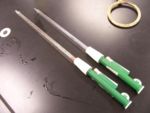Chemical glassware
This article contains a photographic list and brief description of the purpose, benefits, and problems that various pieces of laboratory glassware.
General
Most laboratory glassware is constructed of heat and chemical resistant Pyrex glass so that it can be used for a variety of different purposes and not pose a serious threat to contaminating the reagents held inside. Some of the glassware seen in a chemistry lab also appear in most other laboratory settings. There is ample variety in the shape and construction of laboratory glassware, this is just a brief survey to illustrate the various pieces of glassware a chemist might use on a daily basis.
Beaker
The Beaker is a cylindrical glass vessel serves multiple purposes: to hold reagents during a reaction, to transport or temporarily hold a volume of substance for further use and to measure a large volume that does not require the precision of a container such as a graduated cylinder. These are typically produced from Pyrex glass to withstand heating from a Bunsen burner or electric hot plate as well as being almost chemically neutral in any reaction that may take place within the confines of the container. Beakers come in assorted volumes ranging from a minuscule 1mL to larger >1000mL beakers.
Test Tube
Volumetric Flask
The Volumetric Flask is used to dilute a very specific volume of a solution. Each flask is calibrated to hold a certain volume and only that certain volume. Once the reagents in the solution have been added, the flask is then filled to the calibration line, a small etching around the neck of the flask that was established when the flask was manufactured,
finally the flask is shaken to ensure a homogeneous solution. Due to the specific calibration mark and a general lack of other markings, these flasks are useless in dispensing an arbitrary volume of solution and thus are only used to make solutions.
Pipette
Pipettes in most cases are for removing a volume of liquid from a primary container and transferring it to another container where it may be utilized for another purpose. Pipettes work by adjusting the pressure inside of the glass tube and handle. By increasing the volume of the pipette (rolling the plunger back) the atmospheric pressure outside of the pipette exceeds the air pressure inside of the pipette (Boyle's Law) thus, solution at the open end of the pipette is drawn inside to compensate from the pressure decrease. A valve on the side of the pipette handle allows the atmospheric air to enter the pipette, thus increasing the pressure towards atmospheric. This increase in pressure then forces out the fluid inside the pipette. Other variances of the design exist.



